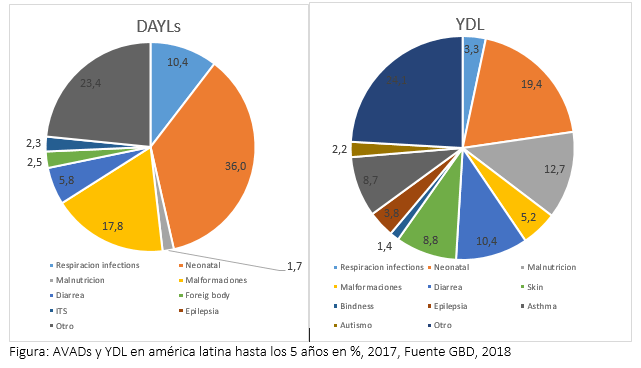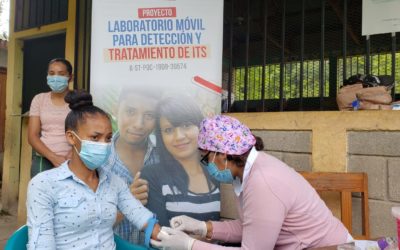A topic of great relevance for the Waal Foundation (FDW) is the situation of disabilities that are generated by deficiencies acquired during pregnancy, childbirth or early childhood.
The GBD (Global Burden Disease [1] ) database allows the number of cases and years lost due to disability (YLD [2 ]) to be selected and determined by regions, causes and some deficiencies. This facilitates an interesting analysis of the disability situation and its possible connection with causes that arise during the initial phases of life. The information serves to better justify and direct primary and secondary prevention actions during pregnancy, the neonatal stage, and early childhood.
Muertes infantiles y Discapacidades comparadas
As a first point, it is interesting to make a global comparison of progress in reducing child deaths and years lost due to disabilities (YDL [1] ) in the FDW countries and some other less developed countries in Latin America and the Caribbean (LAC).
Table: Comparison of infant deaths versus years lost due to disability

Progress in reducing deaths during childhood has been good, however, the situation with disabilities is less favorable. Taking into account the years lost due to disability, the improvement in the LAC region is 17.4% slightly better than the world average of 12.4 %. In the same period, infant deaths have fallen by 69% in LAC and 54% in the world. If we analyze the reduction in years lost due to disability, we see that progress is limited and insufficient. This makes it necessary to carry out greater efforts in policies and concrete actions to promote the prevention of disabilities and reduce their incidence in the region and both social and economic problems.
In the countries where the FDW operates, the improvement in YLDs has been only 1.6% and that is practically thanks to the good reduction in El Salvador and to a lesser extent in Ecuador. Honduras and Bolivia show a decline in terms of years lost due to disabilities during the first 5 years of life of -9.7% and -26.4% respectively. A similar situation is seen in other countries. There is an improvement of 26% in Nicaragua and 4.6% in Peru. In Guatemala and Paraguay the situation worsened, with -13.7% and -8.7% respectively. In contrast, the average improvement in the FDW countries in reducing child deaths has been 68.9%. The reduction in child deaths has been good, but the reduction in YLDs shows modest progress and in some cases, such as in the period from 1990 to 2017, has worsened.
These setbacks or small improvements in the burden of disability compared to advances in child deaths, reflect a lack of systematic attention to the issue of disability (Lancet, 2018). Work on prevention and care for disabilities is necessary because many more children survive during the neonatal phase and childhood, but not always in optimal conditions to take advantage of their potential. Prematurity may be contributing significantly to this burden, especially in upper-middle and middle-income countries. In addition, many of the diseases and deficiencies can be prevented. The March of Dimes (2006) estimates that 70% of congenital malformations can be prevented or mitigated through timely and adequate care.
Las causas de discapacidad y muerte
If we take into account the Disability-Adjusted Life Year or DALY indicator and see its causes throughout all ages, in LAC we see that neonatal complications are an important cause, ranking third with 5.1% of all years lost. . Congenital malformations are in 11th place with 2.6% of DALYs. Taking into account only the years lost due to disability, neonatal complications are the eighth cause with 3.8% of the years lost and congenital malformations represent 1.3%.
They seem relatively small values. However, two things must be taken into account:
- pregnancy, it is a relatively short period (delivery and neonatal period) in which neonatal complications and congenital malformations can be attributed to a person, compared for example with the first cause of YLD, back pain, which can occur throughout the life life.
- Additionally, there are other important causes of DALYs or YLDs that we know are related to pregnancy and early childhood such as diabetes, depression and anxiety, problems with the senses, kidneys or muscles, cardiovascular diseases, problems with the lungs, diseases degenerative diseases and some types of cancers (Lampl, 2017) that are difficult to attribute precisely.
To have a more concrete vision and closer to the phase of life that has our greatest interest, we indicate the DALYs and YLD for children under 5 years of age. The DALYs for children under 5 years of age are composed of 36.0% neonatal disorders, 17.8% congenital malformations, 10.4% respiratory infections and 5.8% diarrhea, while the YLDs for neonatal disorders 19.4%, malnutrition 12.7% (anemia, vitamin a), Diarrhea 10.4%, Dermatitis 8.8%, Asthma 8.7% and congenital malformations 5.2%.

Also in Latin American countries, neonatal disorders (prematurity, sepsis, hemolytic disease, asphyxia, and trauma) and congenital defects are important causes for years lost due to disability (YLD) and years adjusted to disability (DALYs). In Bolivia, Ecuador, Peru, Nicaragua, neonatal disorders are the leading cause of DALYs throughout life. In other countries during the first years of life they are the first cause in all countries.
The malformations are between the 4th. to 13th. causes of DALYs throughout life and during the first 5 years it ranks between 2nd and 4th place. As a cause of disability, malformations are between the 5th to 8th place.

Learn more about the Waal Foundation HERE
Bibliography
Christianson, Howsos, Modell 2006, Global Report on Birth Defects, The hidden toll of dying and disabled children , March of Dimes Birth Defects Foundation. White Plains, New York.
Institute for Health Metrics and Evaluation (IHME). GBD Compare Data Visualization . Seattle, WA: IHME, University of Washington, 2018. Available from http://vizhub.healthdata.org/gbd-compare . (Accessed[28 de Enero 2019] )
Lampl, M. (2017) Fetal life is important for the rest of your life. [Lof Der geneestkunst: Erasmus University]. October 2017.
Lancet 2018, Developmental disabilities among children younger than 5 years in 195 countries and territories, 1990-2016: as systematic analysis for the Global Burden of Disease Study 2016, Lancet Global Health , vol. 6 October 2018.
[1] https://vizhub.healthdata.org
[two] DALY / YLD / YLL: The Disability Adjusted Year of Life or DALY is a health gap measure that extends the concept of potential years of life lost due to premature death (PYLL) to include equivalent years of “healthy” life lost due to being in states of poor health or disability (1). DALYs for a disease or health condition are calculated as the sum of the years of life lost due to premature mortality (YLL) in the population and the years due to disability (YLD) for incident cases of the health condition. (WHO, https://www.who.int/whosis/whostat2006YearsOfLifeLost.pdf)



